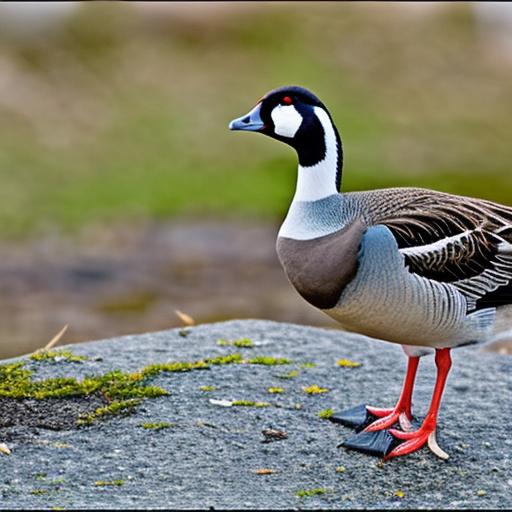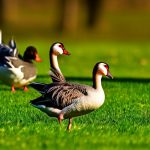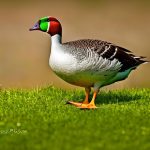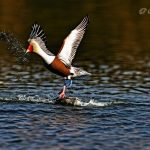Geese infestation is a common problem in many areas, causing damage to property, creating unsanitary conditions, and posing safety risks. Finding humane solutions to deter geese is crucial in order to address this issue effectively. By understanding the behavior of Canadian geese and implementing various management techniques, it is possible to create an environment that is less attractive to geese and encourage them to find alternative habitats.
Key Takeaways
- Canadian geese are attracted to open spaces near water and grassy areas.
- Physical barriers such as fences and netting can be effective in deterring geese.
- Natural repellents like grape extract and predator urine can also keep geese away.
- Creating a hostile environment by removing nesting sites and reducing food sources can discourage geese from staying.
- Sound and visual deterrents like decoys and noise makers can be used to scare geese away.
Understanding the Behavior of Canadian Geese
Canadian geese are known for their distinctive appearance, with a long neck, large body, and characteristic honking sound. They are migratory birds that travel in large flocks and are attracted to areas with open water, ample food sources, and suitable nesting sites. Understanding these characteristics can help in developing effective strategies to deter geese.
One reason why geese are attracted to certain areas is the availability of food. Geese are herbivores and feed on grasses, grains, and aquatic plants. Areas with lush green lawns or open fields provide an abundant food source for geese. Additionally, geese are attracted to bodies of water such as ponds or lakes, as they provide a safe habitat for nesting and access to food.
Implementing Physical Barriers to Deter Geese
Physical barriers can be an effective way to deter geese from certain areas. There are various types of physical barriers that can be used, including fences, netting, and hazing devices. Fences can be installed around areas where geese are not wanted, such as parks or golf courses. Netting can be used to cover bodies of water or specific areas where geese tend to congregate. Hazing devices, such as motion-activated sprinklers or noise-making devices, can also be effective in deterring geese.
When installing physical barriers, it is important to consider the height and durability of the barrier. Geese are capable of flying and can easily jump over low fences or break through flimsy netting. It is also important to regularly inspect and maintain the barriers to ensure their effectiveness. Additionally, it may be necessary to obtain permits or permissions from local authorities before installing certain types of physical barriers.
Utilizing Natural Repellents to Keep Geese Away
Natural repellents can be used to deter geese from certain areas without causing harm to the birds. There are various types of natural repellents that can be effective in deterring geese, including visual deterrents, taste deterrents, and scent deterrents.
Visual deterrents, such as scarecrows or reflective tape, can create a sense of danger for geese and discourage them from entering an area. Taste deterrents, such as bitter sprays or granules, can make the grass or plants in an area unappealing to geese. Scent deterrents, such as predator urine or essential oils, can create a strong odor that geese find unpleasant.
When using natural repellents, it is important to follow the instructions provided by the manufacturer and apply them properly. It may be necessary to reapply the repellents periodically, especially after rain or heavy watering. It is also important to consider the potential impact of the repellents on other wildlife or pets in the area.
Creating a Hostile Environment for Geese
Creating a hostile environment for geese involves making an area less attractive to them by removing or modifying their preferred habitat and food sources. This can be achieved through various techniques such as landscaping changes, habitat modification, and reducing access to food.
One way to make an area less attractive to geese is by implementing landscaping changes. This can include planting native vegetation that is less appealing to geese or creating barriers using rocks or shrubs that make it difficult for geese to access certain areas.
Habitat modification can also be effective in deterring geese. This can involve altering the shoreline of a pond or lake to make it less suitable for nesting or removing vegetation that provides cover for geese.
Reducing access to food sources is another important aspect of creating a hostile environment for geese. This can be achieved by regularly removing fallen fruit or seeds, covering compost piles, and securing garbage cans to prevent geese from accessing food scraps.
Employing Sound and Visual Deterrents

Sound and visual deterrents can be effective in deterring geese by creating a sense of danger or discomfort. There are various types of sound and visual deterrents that can be used, including predator decoys, noise-making devices, and laser lights.
Predator decoys, such as fake owls or coyotes, can create the illusion of a predator presence and deter geese from entering an area. Noise-making devices, such as propane cannons or ultrasonic devices, can emit loud noises that scare geese away. Laser lights can create a visual disturbance that makes geese uncomfortable and encourages them to find an alternative habitat.
When using sound and visual deterrents, it is important to consider the potential impact on other wildlife or pets in the area. It is also important to regularly move or change the location of the deterrents to prevent geese from becoming accustomed to them.
Establishing a Regular Maintenance Routine
Regular maintenance is crucial in order to ensure the effectiveness of geese management techniques. This involves regularly inspecting physical barriers, reapplying natural repellents, and making necessary changes to the environment.
Inspecting physical barriers on a regular basis helps identify any damage or weaknesses that may need to be repaired. It is also important to remove any debris or vegetation that may have accumulated around the barriers, as this can provide a pathway for geese to enter an area.
Reapplying natural repellents periodically is necessary to maintain their effectiveness. This is especially important after rain or heavy watering, as the repellents may be washed away. It is also important to monitor the effectiveness of the repellents and make necessary adjustments if geese are still entering the area.
Making necessary changes to the environment involves regularly assessing the effectiveness of the management techniques and making adjustments as needed. This may involve modifying landscaping, adding additional deterrents, or implementing new strategies based on the behavior of the geese.
Properly Disposing of Food Sources to Prevent Attraction
Properly disposing of food sources is crucial in preventing geese from being attracted to an area. This involves ensuring that garbage cans are securely closed and not overflowing, covering compost piles, and regularly removing fallen fruit or seeds.
Geese are attracted to areas with abundant food sources, and improperly disposed of food can be a major attractant. By properly disposing of food sources, it reduces the likelihood of geese being attracted to an area and encourages them to find alternative habitats.
It is also important to educate others in the community about the importance of properly disposing of food sources and the impact it can have on geese populations. By working together to prevent the availability of food sources, it can help reduce the likelihood of geese infestation in an area.
Seeking Professional Assistance for Geese Control
In some cases, seeking professional assistance may be necessary to effectively manage geese infestation. Professional wildlife control companies have experience and expertise in dealing with geese and can provide effective solutions tailored to specific situations.
Professional assistance may be necessary if other management techniques have been unsuccessful or if the geese infestation is particularly severe. Wildlife control companies can provide services such as trapping and relocation, habitat modification, and ongoing maintenance.
It is important to research and choose a reputable wildlife control company that uses humane methods and follows local laws and regulations regarding geese control. Working with professionals can help ensure that geese infestation is addressed effectively and in a humane manner.
Educating Others on Geese Management Techniques
Educating others in the community about geese management techniques is crucial in order to address the issue effectively. By raising awareness and providing information on humane solutions, it encourages individuals and organizations to take action and implement geese management strategies.
One way to educate others is by organizing community workshops or seminars on geese management. These events can provide information on the behavior of geese, the impact of geese infestation, and various management techniques that can be used. It also provides an opportunity for individuals to ask questions and learn from experts in the field.
Another way to educate others is by distributing educational materials such as brochures or flyers. These materials can be distributed at community centers, schools, or local businesses to raise awareness about geese management techniques and encourage individuals to take action.
It is also important to utilize social media and other online platforms to share information and resources on geese management. This can include posting articles, videos, or infographics that provide tips and strategies for deterring geese. By reaching a wider audience through online platforms, it helps spread awareness and encourages individuals to implement geese management techniques.
Respecting Laws and Regulations Regarding Geese Control
When implementing geese management techniques, it is important to respect laws and regulations regarding geese control. Many countries have laws in place to protect migratory birds, including Canadian geese, and it is important to ensure that any management techniques used are in compliance with these laws.
Before implementing any management techniques, it is important to research and understand the laws and regulations specific to the area. This may include obtaining permits or permissions from local authorities before installing physical barriers or using certain deterrents.
It is also important to consider the potential impact of management techniques on other wildlife or the environment. Using humane methods that do not cause harm to geese or other animals is crucial in order to address the issue effectively and ethically.
In conclusion, geese infestation is a common problem that can cause damage, create unsanitary conditions, and pose safety risks. Finding humane solutions to deter geese is crucial in order to address this issue effectively. By understanding the behavior of Canadian geese and implementing various management techniques, it is possible to create an environment that is less attractive to geese and encourage them to find alternative habitats. It is important to respect laws and regulations regarding geese control and educate others in the community about geese management techniques. By working together, it is possible to find humane solutions to deter geese and mitigate the impact of geese infestation.
If you’re looking for effective ways to keep Canadian geese away from your property, you might also be interested in learning about what vegetables quails eat. Quails are small birds that can be kept as pets or for their eggs. Poultry Wizard provides a helpful article on their website that discusses the different types of vegetables that quails enjoy. By incorporating these vegetables into your garden or landscaping, you can create a natural deterrent for Canadian geese while also providing a nutritious diet for your quails. Check out the article here to learn more about keeping both your quails and Canadian geese happy.
FAQs
What are Canadian geese?
Canadian geese, also known as Canada geese, are large waterfowl native to North America. They are known for their distinctive black heads and necks, white cheeks, and brown bodies.
Why do Canadian geese become a nuisance?
Canadian geese can become a nuisance due to their droppings, aggressive behavior, and tendency to damage property such as lawns, crops, and gardens. They can also pose a threat to human safety, especially in areas where they congregate in large numbers.
How can I keep Canadian geese at bay?
There are several methods to deter Canadian geese, including using visual deterrents like scarecrows or reflective tape, installing physical barriers such as fences or netting, using noise deterrents like propane cannons or ultrasonic devices, and employing trained dogs to chase the geese away. It is important to use a combination of these methods for the best results.
Is it legal to harm Canadian geese?
Canadian geese are protected under the Migratory Bird Treaty Act in the United States and the Migratory Birds Convention Act in Canada. It is illegal to harm, harass, or kill Canadian geese without the proper permits. It is important to consult with local wildlife authorities before taking any action to deter Canadian geese.
Are there any natural ways to keep Canadian geese away?
Some natural ways to keep Canadian geese away include planting tall grasses or shrubs along water edges to create a barrier, using floating swan decoys to deter geese from landing in water bodies, and allowing natural predators like foxes or coyotes to roam in the area. However, these methods may not always be effective in deterring geese.
Meet Walter, the feathered-friend fanatic of Florida! Nestled in the sunshine state, Walter struts through life with his feathered companions, clucking his way to happiness. With a coop that’s fancier than a five-star hotel, he’s the Don Juan of the chicken world. When he’s not teaching his hens to do the cha-cha, you’ll find him in a heated debate with his prized rooster, Sir Clucks-a-Lot. Walter’s poultry passion is no yolk; he’s the sunny-side-up guy you never knew you needed in your flock of friends!







